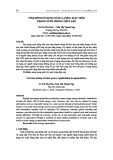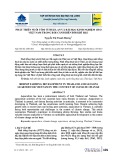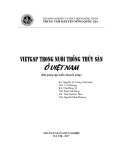
http://www.iaeme.com/IJM/index.asp 199 editor@iaeme.com
International Journal of Management (IJM)
Volume 8, Issue 2, March – April 2017, pp. 199–208, Article ID: IJM_08_02_021
Available online at
http://www.iaeme.com/ijm/issues.asp?JType=IJM&VType=8&IType=2
Journal Impact Factor (2016): 8.1920 (Calculated by GISI) www.jifactor.com
ISSN Print: 0976-6502 and ISSN Online: 0976-6510
© IAEME Publication
FOOD SAFETY MANAGEMENT SYSTEMS IN
INDIAN SEAFOOD EXPORT INDUSTRY- THE
CASE OF KERALA
Asha Raymond
School of Industrial Fisheries, Cochin University of Science and Technology (CUSAT), Fine
Arts Avenue, Kochi- 682022, Kerala, India.
AlappatRamachandran
Kerala University of Fisheries and Ocean Studies (KUFOS), Panangad, Kochi, 682506, India.
ABSTRACT
Indian Fishery trade has expanded considerably in recent decades and this has
been an important source of foreign exchange for the country with total earnings of
US$ 5.5 billion in 2014-15.In the interests of food safety and consumer protection,
increasingly stringent hygiene measures have been adopted at national and
international trade levels. Food safety regulations regime has completely restructured
the seafood value chain in India. There has been a proliferation of sector oriented
standards and Codes of Practices (COPs) incorporating a range of standards relating
to all the elements that make up the food management chain. Major constraints faced
by the seafood exporters in Kerala to comply with the above standards and code of
practices were identified. Addressing food safety concerns and its implementation in
India will require the joint efforts by the government and the private sector.
Key word: FSMS,Seafood Trade, Private standards,Certifications, Kerala,
Compliance.
Cite this Article: Asha Raymond and Alappat Ramachandran, Food Safety
Management Systems In Indian Seafood Export Industry- The Case of Kerala,
International Journal of Management, 8(2), 2017, pp. 199–208.
http://www.iaeme.com/IJM/issues.asp?JType=IJM&VType=8&IType=2
1. INTRODUCTION
Indian Fishery trade has expanded considerably in recent decades and this has been an
important source of foreign exchange for the country with total earnings of US$ 5.5 billion in
2014-15. India’s share in the global fish production constituted around 5.4% and it is the
second largest fish producing nation in the world. India is second major producer of
aquaculture in the world producing 7 per cent of the world output (Ababouch&karunasagar,
2013). The fishery sector contributes about 0.9% to the National GDP, and approximately,
5.17% of the agricultural GDP (DAHD, 2015). The seafood processing and export industry

Asha Raymond and Alappat Ramachandran
http://www.iaeme.com/IJM/index.asp 200 editor@iaeme.com
contributes significantly to the Indian economy in terms of employment and foreign exchange
earnings. Historically, Indian exports of fish and fishery products have been directed at 3
major markets: the European Union (EU), Japan, and the United States. However, the Indian
export destinations changed significantly with the emergence of Southeast Asia as the
important market that account for over 38.99 percent of Indian exports in 2014-2015. The
way fishery products are prepared, marketed and delivered to consumers has changed
significantly during recent years. With the current demand pattern of major seafood markets
and with modern machinery for freezing and processing, several exporting firms have started
development and exports of processed value added products (Salim&Narayanakumar, 2012).
Historically, India has faced a number of challenges meeting hygiene requirements for
fish and fishery products in its major export markets, especially the EU and US. Throughout
the 1980s and early 1990s, the major source of problems for Indian exporters was the US.
While the processing sector expanded rapidly through the 1990s, hygiene controls did not
keep pace with emerging requirements in India’s major export markets. Since the mid-1990s,
the major concern has been compliance with the EU’s requirements for hygiene throughout
the fish supply chain, alongside the U.S. requirements for HACCP to be implemented in fish
processing facilities. Fish and fishery products were subject to compulsory inspection by an
Export Inspection Agency until the end of 1991. India’s standards for hygiene in fish and
fishery products were reformed in 1995. As per the reformation fish and fishery products were
again subject to compulsory inspection and certification. The establishment of HACCP cell
by the Government of India in 1996 to assist the effective implementation of HACCP in the
fishing industry is marked as the first proactive move by the Indian government to enhance
food safety controls in the fish and fishery products sector. In 1999, a more comprehensive
Food Safety Management Systems-Based certification (FSMSC) was introduced for fish and
fishery products along with other commodities. Fish processors wishing to export needed to
be certified under this system. The FSMSC system included mandatory integrated pre-
processing and ice production facility on processing facility, specific limits on daily outputs
and more intensive inspection to EU approved units. (Henson, Saquib&Rajasenan, 2004).The
paper discusses the Food Safety Management Systems (FSMS) prevalent in the Indian
seafood export industry with special reference to Kerala.
2. DETENTIONS AND REJECTIONS OF INDIAN SEAFOOD IN
INTERNATIONAL MARKETS
With the entry of WTO as an international regulatory body on the transnational trade of goods
and services, the global trade environment has undergone a drastic change and has impacted
India’s export of marine products too. Consequently, the agreement on Sanitary and
Phytosanitary (SPS) measures has emerged as a major determinant to the flow of agricultural
products, particularly marine products to the international market. (Shinoj, Ganesh Kumar,
Joshi &Dutta, 2009).
Inspite of the comprehensive food safety measures initiated by the Indian government,
rates of border rejections have increased over time. Recent rejections,however, are only
infrequently related to broader hygiene uses, such as salmonella. Rather, new concerns have
arisen related in particular to residues of antibiotics. Antibiotics and bacterial inhibitors
became the prominent concerns through 2002 and 2004.
Food safety requirements related to general hygiene and specific microbiological and
chemical contaminants in fish and fish products are subject to change over time in response to
emerging problems, advances in scientific knowledge, consumer concerns, and political
pressures. Recognizing this, various countries have put in place stringent rules and regulations
to ensure the quality of imported fish and fishery products.

Food Safety Management Systems In Indian Seafood Export Industry- The Case of Kerala
http://www.iaeme.com/IJM/index.asp 201 editor@iaeme.com
Graph 1 Trends in the import refusals (US) and import notifications (EU/Japan) for the seafood
exports from India.
The trend shows that the largest number of refusals from EU in 2008 and 2009 which was
contributed by the presence veterinary drug residues and heavy metals in fishery products.
Major contribution in this category was due to the presence of nitro furan and its metabolites
which constituted about 59% and heavy metals like Mercury and Cadmium (16%). The
presence of cadmium was reported in the cephalopods. There has been a comparative
decrease in the rejection cases due to veterinary drug residues during the recent year which is
constituted by stricter EU regulations. The US trend shows the highest number of refusals
during 2011 and 2012 contributed by the presence of microbial pathogens mainly salmonella
(48%) which was closely followed by the presence of filth or unsanitary substances
(35.2%).The highest number of rejections has been reported in the shrimp and prawn varieties
(70.9%) though the quantity of shrimp and prawn exports to US during these years have been
less than half of the quantity of fish varieties exported. The trend also shows an increase in the
rejection cases due to veterinary drug residues during the recent years constituted by the farm
grown shrimp and prawn varieties, a major delicacy in the US. The trend in Japanese import
notifications shows a sudden increase in the number of rejections of Indian seafood due to the
presence of chemicals, commonly furazolidone and ethoxyquin (94.1%). Frozen Shrimp
constituted the highest number of rejections. Rejections due to microbial hazards constituted
only a very low percentage.
3. FOOD SAFETY CONCERNS IN KERALA SEAFOOD EXPORT
INDUSTRY
Beyond the basic hygiene requirements laid down by India’s main markets, namely, EU,
Japan, and U.S, exporters face a large number of issues. A survey was conducted at the
seafood exporting companies in Kerala to assess the major food safety concerns. Assuming
that the economies of scale would work towards reducing the cost of food safety compliance,
the respondents were asked to mention their size and production capacity of the firm. The
companies were then categorized based on their production capacity (below 15 Tonnes, 16-30
Tonnes, 31-50 Tonnes and above 50 Tonnes) . The constraints faced by the exporters were
categorized against four parameters, insufficient financial resources, inadequate testing and
inspection facilities, inadequate trained manpower, non-harmonization of food safety
standards, and traceability. The Graph (1) shows the response obtained.
0
20
40
60
80
100
120
140
No. of Refusals/ notifications
Trends in the number of refusals (EU/US/Japan)
for seafood exports from India, 2005-2015
US
EU
JAPAN

Asha
http://www.iaeme.com/IJM
/
Graph 2 Constraints
faced b
The trend showed significa
capacity of the firms. The larg
food safety concerns which w
Traceability was found to be t
study.
4.
THE EVOLUTION O
STANDARDS/CERTIFI
INDUSTRY.
Major share of the Kerala se
dominated by frozen shrimp
exports and the increase in th
due to food safety are also o
exports on food safety groun
problems in the supply chain
metals, and microbial contami
and often dominant share of
(FAO, 2011a). The present se
The exporters has
little bargain
chain managers to change th
related to safety, quality etc. s
the relationship.
(Somasekhara
The food quality and safet
organization and managemen
industry. Particularly for
high
concerns dominate the comp
adoption of these FSMS by th
of such sys
tems, each with
processes (Albersmeier, Schul
increasingly important role i
international trade.
The adopt
they have become de facto ma
ha Raymond
and Alappat Ramachandran
/index.asp
202
ed
by the seafood exporters in Kerala towards food sa
ican
t relation between the food safety concerns
arger the firm with more production capacity
was mainly contributed by the
financial str
e the least of all the other concerns for almost
OF PRI
VATE/VOLUNTARY
FICAT
IONS IN KERALA SEAFO
OD
seafood export is contributed
by marine cap
p and cephalopods. With the diversification
the export of processed and value added seafo
on rise. Concerns
over numerous rejections
unds have generated greater attention to per
in including high levels of chemical residues,
minat
ion. The supermarket sector has risen to
f food retailing, commonly 70 per cent in d
seafood value chain in Kerala is buyer driven
aining power and get subjected to pressure from
the production method, cut labour cost, imp
. so that the retailer can maximize the comme
aran, Harilal& Thomas
, 2015).
fety management systems have evolved as the
ent of food production systems in the agri
gh value agricultural and food products food
petition than
the price (Busch &
Bain, 200
the food retail and commercial sectors has led
th its own standards, accreditation, auditing
ulze, Jahn& Spiller,
2009). Priva
te food stand
in food safety governance and determining
ptions of these standards in agribusiness are
mandatory as ignoring them is tantamount to
editor@iaeme.com
safety compliance
ns and the production
y the lesser were the
strength
of the firm.
st all the firms under
D EXPORT
apture, with exports
on of Indian marine
afood, the challenges
ns of Indian seafood
ervasive food safety
s, presence of heavy
to have an important
developed countries
en or direct network.
om the importers and
pose new standards
mercial advantage of
the key driver for the
ribusiness and food
d safety and quality
004).The widespread
d to the proliferation
ing and certi
fication
ndards are playing an
ng market access in
e so widespread that
o losing a significant

Food Safety Management Sy
http://www.iaeme.com/IJM
/
share of the market (Bush and
labelling and certification pr
diversifying a product to make
Private food safety
standa
coalitions and aim to facilitat
and competitive international
private food safety schemes h
chain operators for ensuring fo
increasing consumer awarenes
particular, on food safety
(FAO
Private/voluntary food saf
2001.
Every fish processing
based quality and safety man
bodies too.
A survey conduc
exporting companies opting f
Graph 3 represents the trend
seafood export sector in Keral
2012.
There has been a shift in
which combined ISO 22000 w
of BAP certifications also sho
products to meet the buyer de
certified against an
y one of th
Companies that choose to bec
hence a regime of competition
go for multiple certifications
certifications.
Graph 3
Trends in the Food Safe
The FSMS certifications m
Organisation for Standardisat
22000, BRC (British Retail
(Global Aquaculture Alliance/
An overview of the
food sa
represented in the figure 1 wh
along with the certifications
agencies. 90% of the certifie
0
1
2
3
4
5
6
7
8
9
2001-2003 2004-
20
Systems In Indian Sea
food Export Industry-
Th
/index.asp
203
ed
nd Bain,
2004; Henson, 2007; Fuchs &
Kalfag
programmes can be considered as an impo
ke it seem different from others. (Anderson
&
V
dards are generally set by private
firms an
tate supply chain management within an incre
al food market. The main drivers for the pro
s have been: the clea
r assignment of legal res
food safety; increasingly global and complex
ess of food and food systems and their impac
AO, 2010).
afety certifications in Kerala seafood export
g establishments, that has implemented the m
anagement programme, get certified by
these
ucted on the Kerala seafood export sector re
g for the private food safety systems were o
d in adopting the private/ vol
untary food saf
rala.
It shows that the certifications went on to
in the preference for the newly certified compa
with PAS
220:2008 and five additional require
hows a recent hike with the increase dependen
demands.
25% of the total seafood exporting f
the private /voluntary standards and the proce
ecome certified have a choice among differen
on exists among
standards (Fagoto, 2014). In so
ns too, 50% of the certified companies in Ke
afety Certifications in Kerala Seafood Export Indus
s most prevalent
in Kerala seafood industry are
sation) 22000: 2005, FSSC (Food Safety Sy
il Consortium),IFS (International Food Stand
e/Best Aqua
culture Practices).
safety management system in the Kerala seafo
which includes the private/ voluntary standard
ns and registrations
manda
ted by the gove
fied companies supplied the processed or va
2006
2007-2009 2010-2012 2013-2015
ISO
BR
FSS
22
IFS
BA
The Case o
f Kerala
editor@iaeme.com
ag
ianni, 2010). These
portant strategy for
Valderrama, 2009)
and standard setting
creasingly globalised
proliferation of these
esponsibility to food
x supply chains; and,
act on health and, in
rt sector started from
mandatory HACCP
se private certifying
revealed number of
on rise
since 2001.
afety systems in the
to a peak in 2009 and
panies to FSSC 2000
irement. The number
ency on aquacultured
g firms in Kerala are
cess is still going on.
ent private standards,
some cases the f
irms
Kerala own multiple
ustry from 2001
- 2015.
are
ISO (international
ystem Certification)
ndard)
&GAA-BAP
afood export sector is
rds and certifications
vernment authorized
value added seafood
ISO 22000
BRC
FSSC
22000
IFS
BAP












![Kỹ thuật nuôi thâm canh cá lóc trong ao đất: Tài liệu [chuẩn/mới nhất]](https://cdn.tailieu.vn/images/document/thumbnail/2025/20250724/kimphuong1001/135x160/3731753342195.jpg)




![Kỹ thuật nuôi cá nâu trong ao đất: Tài liệu [Mới nhất]](https://cdn.tailieu.vn/images/document/thumbnail/2025/20250723/vijiraiya/135x160/29781753257641.jpg)
![Kỹ thuật nuôi cá mú trong ao đất: Tài liệu [Mới nhất]](https://cdn.tailieu.vn/images/document/thumbnail/2025/20250723/vijiraiya/135x160/85681753257642.jpg)




![Kỹ thuật nuôi tôm sú quảng canh cải tiến 2 giai đoạn: Tài liệu [Chuẩn nhất]](https://cdn.tailieu.vn/images/document/thumbnail/2025/20250722/vijiraiya/135x160/77611753171890.jpg)

![Quy trình kỹ thuật nuôi tôm siêu thâm canh công nghệ biofloc: Tài liệu [chuẩn/mới nhất]](https://cdn.tailieu.vn/images/document/thumbnail/2025/20250722/vijiraiya/135x160/99851753171891.jpg)
